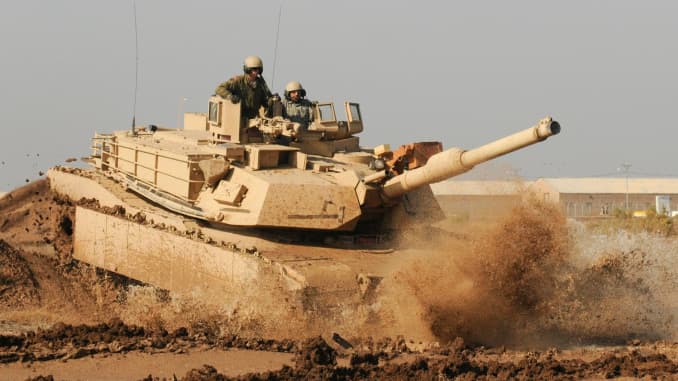Here’s how America’s top five defense firms — Boeing, Lockheed Martin, General Dynamics, Northrop Grumman and Raytheon — did during second-quarter earnings.
Next week, the Senate will vote on a $1.3 trillion budget deal that includes $738 billion for defense spending.
Crewmasters prepare to refuel an F/A-18 Hornet over the W-291 training area in southern California, March 6, 2019.
Sgt. Dominic Romero | U.S. Marine Corps
WASHINGTON — Nobody spends money on arms like the United States, and it shows in the bottom lines of the biggest defense contractors.
The Trump administration’s 2019 defense-friendly spending bill increased the Pentagon’s spending power to a grand total of $717 billion. Next week, the Senate will vote on a $1.3 trillion budget deal for fiscal year 2020 that includes $738 billion for defense.
This week, America’s top five defense firms — Lockheed Martin, Boeing, General Dynamics, Northrop Grumman and Raytheon — posted their second-quarter earnings. While the companies’ quarterly performances remained strong, collectively their stocks were largely unchanged. The iShares U.S. Aerospace and Defense ETF was slightly higher for this week after the companies reported. So far this year the benchmark ETF is up nearly 26%.
Here’s how America’s defense industry giants did.
Lockheed Martin

An F-35 jet flies above Royal Navy aircraft carrier HMS Queen Elizabeth.
Dane Wiedmann | Lockheed Martin
Lockheed Martin’s stock initially popped after the company reported strong second-quarter results, but shares slid during the day and closed negative. The Pentagon’s biggest weapons supplier showed another solid quarter and the company raised its 2019 forecast for both earnings and revenue.
The defense giant now expects full-year earnings between $20.85 a share and $21.15 a share, with revenue expected between $58.25 billion and $59.75 billion. Lockheed Martin saw all four of its business units deliver year-over-year increases in operating profit for this quarter. Lockheed’s order backlog grew “to a new record level,” Chairman, President and CEO Marillyn Hewson said in a statement, with $136.7 billion in total orders booked.
Hewson also said that hypersonic weapons contracts will account for $3.5 billion across the company once all of the deals are finalized.
Boeing

U.S. Navy Aviation Electronics Technician signals to the crew of an EA-18G Growler on the flight deck of aircraft carrier USS Carl Vinson.
Department of Defense photo
Boeing’s defense business stayed strong in the second quarter, although investors focused on the company’s commercial airplane unit and the stock slid. The Pentagon’s second-largest contractor logged a $6.6 billion increase in revenue during the second quarter, with a bump in production volume of weapons programs, satellites and F/A-18 fighter jets driving the increase.
Additionally, Boeing received several valuable Department of Defense contracts in the quarter. Those contracts included $194 million more to build next-generation MH-47G Chinook helicopters and $250 million to build the Joint Direct Attack Munition (JDAM) bomb for the Air Force.
Raytheon

U.S. Soldiers talk after a routine inspection of a Patriot missile battery at a Turkish military base in Gaziantep, Turkey.
Department of Defense photo
Raytheon, the world’s largest missile manufacturer, saw earnings of $2.92 a share on net sales of $7.2 billion. The company’s backlog swelled to $43.1 billion, an increase of $3.3 billion or 8% compared with the same period last year. The defense firm also raised its full-year 2019 guidance for sales, earnings per share and operating cash flow.
The company’s Integrated Defense Systems unit reported $264 million in operating income in the second quarter, booking $485 million and $375 million to provide the Patriot missile defense system to Romania and Qatar, respectively.
Raytheon Chairman and CEO Thomas Kennedy said the merger with United Technologies is “progressing well” and he expects the transaction to close in the first half of next year.
Northrop Grumman

A U.S. Air Force B-2 Spirit bomber aircraft approaches the rear of a KC-135 Stratotanker aircraft before refueling during a training mission over the Midwest, Aug. 1, 2013.
Airman 1st Class John Linzmeier | U.S. Air Force
Shares of Northrop Grumman climbed 5.9% after the company reported second-quarter earnings of $5.06 a share, well above the $4.68 a share expected by Wall Street analysts surveyed by FactSet. With revenue also strong at nearly $8.5 billion, all four of Northrop’s business units saw improved profits in the quarter compared with the same time last year. Increasing production of the F-35 fighter jet drove the increase in Northrop’s aerospace business, where sales in the second quarter rose 1.6% to about $3.4 billion year over year.
The defense giant said its backlog rose by 10%, with about $63 billion in total orders. Northrop bumped up its full year 2019 forecast to a range of $19.30 a share to $19.55 a share — increased from the company’s previous guidance of $18.90 a share to $19.30 a share.
General Dynamics

An Iraqi Army M1A1 Abrams tanker crew trains alongside U.S. counterparts at Camp Taji, Iraq.
US Army photo
General Dynamics reported second-quarter 2019 revenue of $9.6 billion, up 4% year over year, with net earnings of $806 million.
The company’s aerospace unit snatched up $2.2 billion in orders during the quarter, including $495 million from the U.S. Navy for work on the Columbia-class ballistic missile submarine program, $360 million in contracts to provide intelligence services to classified customers and $260 million from the U.S. Army for production of munitions.


Δεν υπάρχουν σχόλια:
Δημοσίευση σχολίου